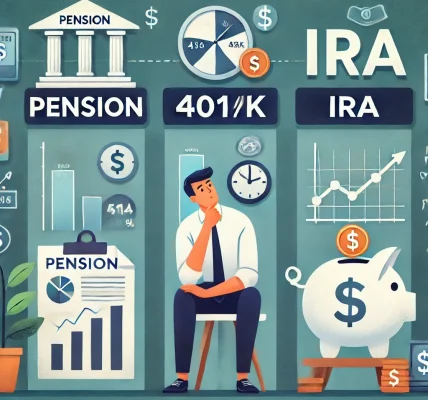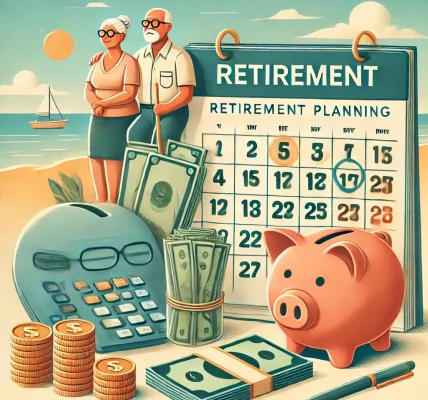Introduction
Planning for retirement is crucial to ensure financial security in your later years. One of the safest and most reliable ways to build your retirement savings is through government-backed retirement plans. These plans are designed to offer stability, tax benefits, and long-term financial security, making them a preferred choice for millions of individuals.
In this article, we will explore the top government-backed retirement plans, their benefits, and how they can help you achieve a stress-free retirement.
1. Social Security Retirement Benefits
What is Social Security?
Social Security is a federally funded retirement program in the U.S. that provides financial benefits to eligible retirees, disabled individuals, and survivors of deceased workers. It is funded through payroll taxes under the Federal Insurance Contributions Act (FICA).
Key Benefits:
✅ Guaranteed Income for Life – Provides monthly payments based on earnings history. ✅ Cost-of-Living Adjustments (COLA) – Payments increase with inflation. ✅ Survivor Benefits – Spouses and dependents may receive financial support. ✅ Disability Protection – Provides financial aid if you become disabled before retirement.
Who is Eligible?
To qualify, you must have worked for at least 10 years and earned a minimum of 40 work credits.
How to Maximize Benefits:
- Delay claiming Social Security benefits until age 70 for higher monthly payments.
- Keep working to increase your lifetime earnings, which determines your benefit amount.
2. 401(k) Retirement Plan
What is a 401(k)?
A 401(k) is an employer-sponsored retirement savings plan that allows employees to contribute a portion of their salary before taxes. Some employers also provide matching contributions, which helps boost retirement savings.
Key Benefits:
✅ Tax-Deferred Growth – Contributions grow tax-free until withdrawal. ✅ Employer Matching – Free money from your employer if they offer a match. ✅ Higher Contribution Limits – In 2024, individuals can contribute up to $23,000 (with an additional $7,500 catch-up contribution for those over 50). ✅ Investment Choices – Funds are invested in stocks, bonds, and mutual funds for potential growth.
Who is Eligible?
Employees working for a company that offers a 401(k) plan.
How to Maximize Benefits:
- Contribute at least enough to get full employer matching.
- Diversify investments to maximize returns and reduce risks.
- Avoid early withdrawals to prevent penalties and loss of compound growth.
3. Individual Retirement Accounts (IRA & Roth IRA)
What is an IRA?
An IRA is a tax-advantaged retirement account that individuals can open independently, without employer sponsorship. There are two main types:
🔹 Traditional IRA – Contributions are tax-deductible, and withdrawals in retirement are taxed. 🔹 Roth IRA – Contributions are made with after-tax income, but withdrawals in retirement are tax-free.
Key Benefits:
✅ Tax Advantages – Choose between tax-deferred growth (Traditional IRA) or tax-free withdrawals (Roth IRA). ✅ Flexible Investment Options – Invest in stocks, bonds, mutual funds, and ETFs. ✅ No Employer Requirement – Anyone with earned income can open an IRA.
Who is Eligible?
Anyone earning taxable income can contribute to an IRA, though income limits apply for Roth IRA contributions.
How to Maximize Benefits:
- If you expect a higher tax rate in retirement, consider a Roth IRA.
- Max out contributions (up to $7,000 in 2024, with a $1,000 catch-up for 50+).
- Diversify investments for optimal growth.
4. Pension Plans (Defined Benefit Plans)
What is a Pension Plan?
A pension plan is a retirement plan funded by employers that provides retirees with guaranteed monthly income based on salary and years of service.
Key Benefits:
✅ Fixed Lifetime Income – Ensures financial security in retirement. ✅ Employer Contributions – No need to contribute personally in most cases. ✅ Protection from Market Risks – Unlike 401(k), your pension benefits are not affected by stock market fluctuations.
Who is Eligible?
Government employees, military personnel, and some private-sector workers with employer pension plans.
How to Maximize Benefits:
- Stay with an employer long enough to become fully vested in the pension plan.
- Understand your pension payout options (lump sum vs. monthly annuity).
5. Thrift Savings Plan (TSP) – For Federal Employees
What is TSP?
The Thrift Savings Plan (TSP) is a government-backed retirement savings plan available to U.S. federal employees and military personnel.
Key Benefits:
✅ Low Administrative Costs – Lower fees than most private-sector retirement plans. ✅ Government Matching – Federal employees can get a 5% employer match. ✅ Diverse Investment Options – Offers various fund choices, including Lifecycle Funds tailored to retirement dates.
Who is Eligible?
Federal employees and uniformed service members.
How to Maximize Benefits:
- Contribute at least 5% to get full employer match.
- Choose investment options that align with your risk tolerance.
Comparison Table of Government-Backed Retirement Plans
| Plan Type | Tax Benefits | Employer Match | Investment Choices | Lifetime Income |
|---|---|---|---|---|
| Social Security | Taxed at withdrawal | ❌ No | ❌ No | ✅ Yes |
| 401(k) | Tax-deferred | ✅ Yes | ✅ Yes | ❌ No |
| IRA (Traditional & Roth) | Tax-deferred (Traditional), Tax-free (Roth) | ❌ No | ✅ Yes | ❌ No |
| Pension Plans | Taxed at withdrawal | ✅ Yes | ❌ No | ✅ Yes |
| TSP | Tax-deferred | ✅ Yes (5%) | ✅ Yes | ❌ No |
Conclusion
Government-backed retirement plans offer security, tax advantages, and steady income for retirees. Choosing the right plan depends on your career, financial goals, and risk tolerance.
🔹 If you work for the government or military, the TSP and pension plans are excellent options. 🔹 If you’re employed in the private sector, a 401(k) with an IRA can maximize your savings. 🔹 If you want guaranteed income, Social Security and pension plans provide financial stability.
By leveraging these plans wisely, you can build a solid financial foundation for your retirement and enjoy peace of mind in your golden years. Start planning today to secure your future!




